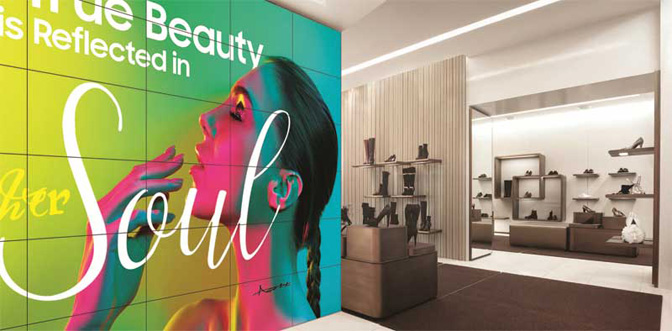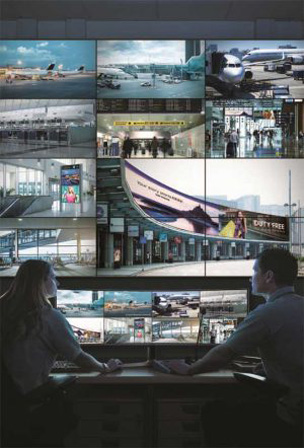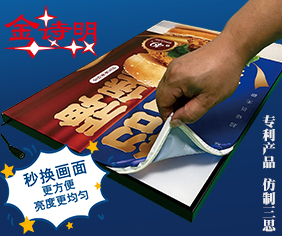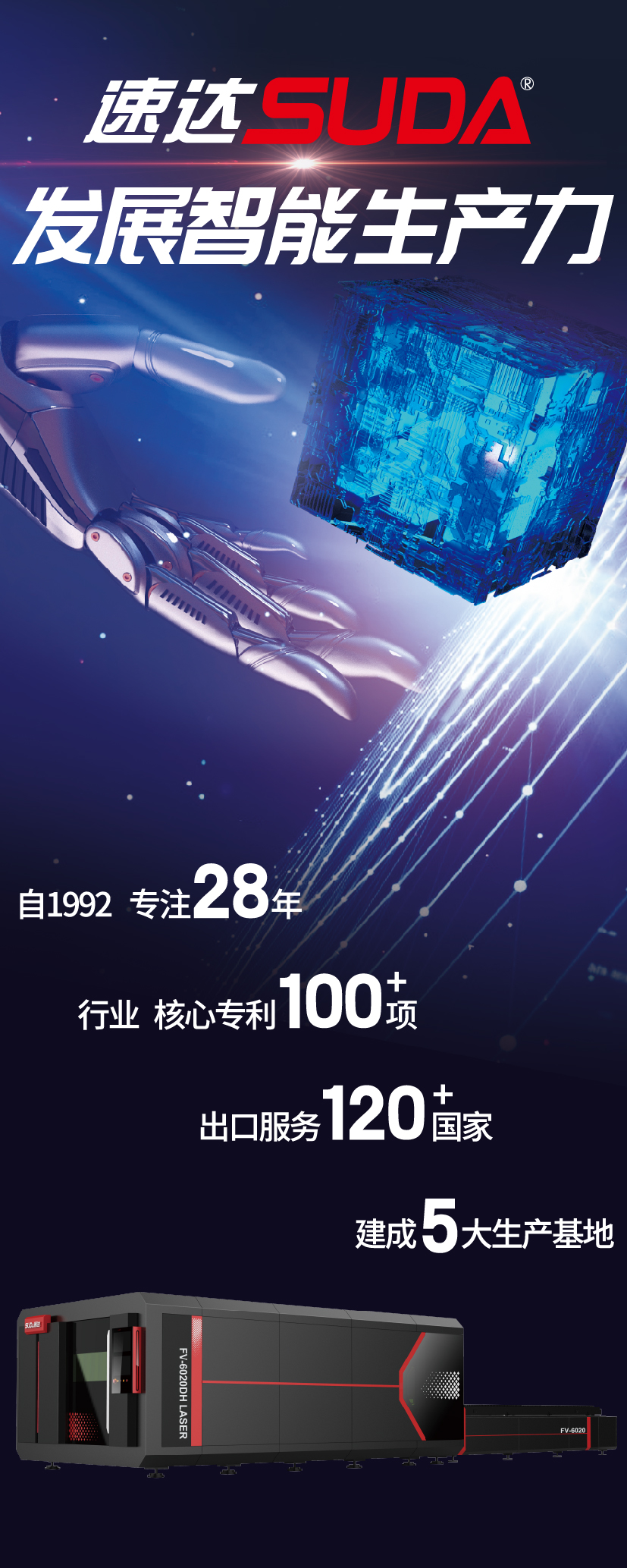
In large retail environments, video walls are used as feature displays and as primary design features.
(在大型零售环境中,数字标识墙一般被用作功能显示)
Visual displays and digital signage have come a long way and have experienced immense growth within the global video wall market in the last few years. That said, why is this trend starting to evolve so rapidly now? Many of the constraints businesses have experienced with video wall displays—like overcoming daylight glare and creating more customized shapes—are becoming issues of the past. Today, sign companies can offer their clients endless video wall capabilities thanks to the latest features of liquid crystal display (LCD) and light-emitting diode (LED) displays. These screens deliver a more immersive, realistic experience with added flexibility.
在过去的几年里,数字标识墙标识有了巨大的发展。标识行业正在朝数字化这个方向靠近。过去,许多企业在使用数字标识墙进行展示时遇到许多限制:比如日光下依然需要很好的显示效果,定制数字标识墙形状等,现在这些问题正在一一被解决,如今的标识公司可以为客户轻松地提供数字标识墙功能,这要归功于最新的液晶显示器(LCD)和发光二极管(LED)显示屏的发展,为客户提供了一种更身临其境、更真实的体验,并增强了标识的灵活性。
That said, video walls are not only successful because the technology fits. Getting the desired outcome of high-quality visuals through LCD and LED video walls requires strategic design, planning, and execution, which is illustrated through a number of instances discussed below. These examples explain how sign companies can use these different technologies to help businesses overcome challenges, as well as demonstrate the direction video walls are headed.
也就是说,数字标识墙的成功一方面是因为数字标识墙本身的效果比较好,市场需求大,另一方面是因为技术的成熟。下面讨论的一些实例也说明了这一点。这些例子解释了标识公司如何使用这些不同的技术来帮助企业克服挑战,同时也展示了数字标识墙的未来发展方向。
Video wall technology is heavily used at many airports, including Edmonton International Airport, where they feature everything from the estimated wait time at security to departure and arrival details.
(皮尔逊国际机场和埃德蒙顿国际机场利用数字数字标识墙传递各种各样的资讯,从估计的安检等待时间到出发和抵达的详细信息)
Two ways to build a video wall
数字标识墙的两种选择
The two most commonly used technologies for creating video walls are LCD and LED—two very different technologies that sometimes get confused.
创建数字标识墙最常用的两种技术是LCD和led——这两种截然不同的技术有时会被混淆。
The current generation of LCD video displays use LED lighting to illuminate a thin liquid crystal layer from behind or around the edges. The latest generation of indoor LED displays is also commonly referred to as ‘direct-view.’ This is due to the viewers’ ability to look directly at the tiny LEDs creating the visual. This differs from LCD, as these screens simply use LED technology as a hidden light source.
之前的LCD视频显示器使用LED进行照明,是从背后或边缘照亮。而最新一代的室内LED显示屏通常是一种直接的照明。因为观众能够直接看到发光二极管,这与LCD仅仅是把LED作为隐藏光源隐藏起来有着很大的不同。
MicroLED technology, the latest innovation in LED displays, transfers micrometre-scale LEDs into modules. The result resembles wall tiles comprised of mass-transferred clusters of almost microscopic lights. Mounted together as a uniform canvas and plugged in, they create a visual experience similar to what one would get with premium quantum dot light-emitting diode (QLED) TVs.
LED显示屏的最新创新是将微米级的LED转换成模块。其结构类似墙砖,整个显示屏由微米的led模组墙组成,作为一个统一整体进行安装和插电,他们创造了一种独特的视觉体验,巨大的数字标识墙仿佛一个电视。
LCD video walls
LCD数字标识墙
LCD video walls deliver high-definition visuals with some showcasing up to 4K ultra-high-definition (UHD) technology. One of the key features separating these displays from LED technology is the ability to have visuals look great from any distance or direction, including wide-viewing angles. Touch interactivity is another feature made possible, as it is easy to introduce by adding overlays or sensor frames around the perimeter of the display.
LCD数字标识墙能够获得高清晰度的画面,甚至展示高达4K超高清(UHD)画面。而区分LCD与LED的关键是,是否可以从任何距离或方向观看这个数字标识墙。触摸交互性是另一个未来可以实现的功能,因为它可以通过在显示器周围添加覆盖层或传感器帧来实现。
LCD video walls are often built by piecing individual displays together in a larger rectangle shape using a variety of clusters. In recent years, some new inventive shapes and clusters have adapted ideas such as herringbone patterns, or used unusual square LCDs to mix and match with more conventional rectangular displays.
LCD数字标识墙一般是将单个显示器拼接成更大的矩形来进行构建。近年来,一些标识公司开始倾向设计一些创意图形,如人字图案,或者使用方形的LCD显示器和传统的矩形显示器进行混搭。
What truly differentiate LCD from LED displays are the frames (bezels) around the edge, which hold the screens in place. Previously, LCD video walls had very noticeable gridlines because of thicker bezels, which resulted in interrupted visuals as they were disturbed by these large seams.
Today, with advances in display technology, the industry is seeing far thinner bezels. The effect is
the seams between the displays almost entirely disappear. LCD screens with ultra-narrow bezels typically carry a premium price. Costs decrease, however, as the bezels get thicker.
真正区分LCD和LED显示器的是边缘的框架,是它将屏幕固定在适当的位置。以前,因为LCD数字标识墙的边框更厚,因而存在非常明显的边框线条,视觉效果就比较一般。如今,随着技术的进步,LCD的边框比之前薄得多,显示器与边框之间的缝隙几乎完全消失了。这种带有超窄边框的LCD显示屏通常价格不菲,一般来说,边框越厚,售价越低。
 In some corporate office spaces, the sign industry is seeing a trend toward using video walls to enhance workplace culture and ambience.
In some corporate office spaces, the sign industry is seeing a trend toward using video walls to enhance workplace culture and ambience.
(在一些企业办公场所,标识行业发现企业倾向用数字标识墙来展示公共艺术,以增强工作场所的文化和氛围)
LED video walls
LED数字标识墙
Direct-view LEDs have been around for a while in the indoor market; however, recently, there has been noticeable growth as a result of the attention they are receiving for their use within a variety of industries.
新型的LED数字标识墙在市场已经出现一段时间,最近它们因为在各种工业中的广泛应用而受到关注,行业有了进一步的增长。
This jump in interest is due to changes in ‘pixel pitch,’ which simply refers to the distance (in millimetres) between the LED light clusters in the digital display. The closer they are the better the resolution—especially when it is viewed up close.
主要是原因是“分辨率”的变化,它指的是数码显示器中LED模组之间的距离(以毫米为单位)。离得越近,分辨率越高,尤其是近距离观看的时候。
Most commonly, LED display technology has been used on highway billboards, as stadium scoreboards, or for running ads in high-traffic areas, such as Yonge-Dundas Square in downtown Toronto. These examples typically use lower resolution pixel pitches, generally 6 mm (0.2 in.) and higher, as the distance they are usually viewed from is quite far.
LED技术最常见的一些应用是:高速公路的广告牌,体育场的记分牌,在交通繁忙地区播放广告的显示屏,比如多伦多市中心的登达士广场。这些情况下对分辨率的要求较低,通常为6毫米(0.2英寸)或更宽,人们观看这些标识的距离相当远。
The new generation of fine pixel pitch indoor LEDs have gaps as fine as 1 mm (0.03 in.) or less. This means they can deliver 1080P HD viewing quality from just 3 m (10 ft) away, and stepping further back, most untrained eyes would struggle to even tell the difference between new generation LED displays and LCD screens.
而新型LED像素之间的间距可达1毫米(0.03英寸)或更小。这意味着在3米(10英尺)远的地方,行人获得的是1080P高清的观看质量,也就是说,大多数人的眼睛甚至很难分辨出新一代LED显示屏和LCD屏幕之间的区别。
One of the smallest pixel pitches available on the market features microLED technology, making it suitable for very small viewing distances, such as a conference room.
市场上能够提供的最小像素间距采用的就是LED技术,它适用于非常小的可视距离,比如会议室里面。
Case in point
适用范围
The opportunities are endless, but the following is a quick look at some industries where sign companies have installed video wall technology.
数字标识墙的适用范围是非常广的,下面是一些标识公司安装数字标识墙的具体适用范围。
Retail
零售行业
The added full motion of digital signage with high-impact visuals reinforces the brand and sets the tone for a store. Video walls are used as feature displays in large retail environments, such as backdrops at checkout and customer service areas, but also as primary design features.
数字标识与高冲击力的视觉效果相互配合,进一步强化公司的品牌形象。在大型零售环境中,数字标识墙一般被用作功能显示,如结帐和客户服务区域的背景,有时也用来展示其相关设计。
Financial institutions use LED walls in branches to create a stunning architectural feature which not only stops passersby in their tracks, but also provides a unique customer experience inside the branch.
金融机构在分行也使用LED数字标识墙,令人惊叹不已,不仅可以吸引了行人的注意,还提供了一个独特的客户体验。
Hospitality
酒店行业
As technology continues to shake up the hospitality industry, hotels are beginning to feature engaging video wall features in their lobbies and main entrances. These digital display solutions can enhance the design of any space, especially as hotels look to maintain their competitive edge and offer a unique and memorable experience for each guest.
随着技术的不断发展,酒店行业也开始在大堂和主要入口安装数字标识墙,增强空间的设计感,还能保持酒店的竞争优势,为每位客人提供独特和难忘的体验。
A recent success story of how this display technology can be effectively implemented can be seen at Edmonton’s Fantasyland Hotel. Here, a large direct-view LED display was installed behind the reception desk to create a stunning visual impact for customers the moment they walk into the hotel. These high-quality displays are being used to relay a variety of messages (e.g. the latest updates on weather, local news, as well as promoting the hotel’s restaurants, spas, and local attractions), including useful traveller information to facilitate faster check-in.
在埃德蒙顿的梦幻世界酒店,你可以看到这种数字标识墙是如何发挥效用的。在前台的后面安装了一个大型LED显示屏,在顾客走进酒店的那一刻就抓住他们的眼球。显示屏可以用来传递各种信息(例如最新的天气、当地新闻,以及宣传酒店的餐厅、水疗中心和当地景点),包括一些有用的旅客信息,以便更快地办理入住手续。
Transportation
交通运输业
Airports, train stations, and bus terminals are also adopting digital video wall technology to broaden the information that can be delivered to travellers. Airports in particular are starting to use wide strips of tiled displays to create changeable images at airline check-in counters and security screening areas. As pertinent travel information tends to change throughout the day, details displayed on a screen keep passengers as up-to-date as possible. This technology is already heavily used at many airports in Canada, including Toronto
机场、火车站和公共汽车总站也在采用数字数字标识墙技术,可以更好的传递给旅客一些信息。特别是在机场开始在登机的时候,在柜台和安检区域使用显示器进行信息传递。由于相关的信息会在一天中不断变化,屏幕上显示的详细信息也会让乘客尽可能了解最新的情况。这项技术已经在加拿大的许多机场得到广泛应用,包括多伦多机场。
Pearson International Airport and Edmonton International Airport, where they feature everything from the estimated wait time at security to departure and arrival details, as well as in-terminal restaurant and retail shop promotions and partner advertising.
皮尔逊国际机场和埃德蒙顿国际机场利用数字数字标识墙传递各种各样的资讯,从估计的安检等待时间到出发和抵达的详细信息,还有航站楼内的餐厅和零售店的促销活动以及合作伙伴的广告。

A command and control room may use a high-resolution liquid crystal display (LCD) video wall to show the fine detail of images and charting.
(指挥控制室可以使用高分辨率LCD数字标识墙来传递图像和图表的详细信息)
Corporate spaces
办公场所
In some corporate office spaces, the sign industry is seeing a trend toward using video walls to display public art to enhance workplace culture and ambience. In other cases, the bezel-less and fine pixel pitch advantages of a microLED video wall also makes it the ideal choice for installation in boardrooms or auditoriums.
在一些企业办公场所,标识行业发现企业倾向用数字标识墙来展示公共艺术,以增强工作场所的文化和氛围。在其他情况下,LED显示屏更薄的边框和像素间距优势也使其成为安装在会议室或礼堂的理想选择。
Fit to purpose
了解你的需求
With so many products to choose from, how can one ensure he/she is selecting the best technology that suits their company’s needs? The following are some aspects a sign company can discuss with their client to help him/her evaluate the different technologies.
有这么多的产品可供选择,如何才能确保自己选择的是最适合公司需要的显示屏呢?以下是标识公司可以与客户讨论的一些方面,以帮助他们更好的进行选择。
Shape: There can be limitations when it comes to setting up LCD displays, usually resulting in more rectangular shaped video walls. Because LED modules piece together like tiles, a more custom-shaped display is achievable. This makes LED displays more suitable to fit into spaces with odd and varied dimensions, including the ability to wrap various configurations.
形状: LCD显示器形状上可能会有一些限制,通常为矩形;而LED模块可以像瓦片一样拼接在一起,因而可以自定义形状。这使得LED显示器更适合适合形状要求比较大的项目。
Lighting: In an area where there are more ambient lighting conditions, LCD displays do not have sufficient light power to make visuals cut through glare. However, some manufacturers offer premium, daylight-readable displays, which work well even in direct sunlight. With LED screens, designed-in brightness wins those battles against direct sunlight. By sharing this knowledge with clients, sign companies can make sure their customers know about the available offerings.
照明:在环境照明比较复杂的区域,LCD显示器没有足够的光功率使使得它在这些光中脱颖而出。当然,也不是全部,有一些制造商也能够提供在强光下依旧显示很好的的显示器。但对比两者能够发现,LED显示屏在这种情况下优势显然更为突出,在强光之下显示的效果更好。你可以与客户分享这些知识,方便客户进行选择。
Distance: When searching for the best display, distance of viewers from the visual needs to be determined. Close proximity best suits LCD because visuals will look vivid and sharp even up close. However, if viewers will be at a distance of 3 m (10 ft) or more, a relatively low-cost 1.5-mm (0.06-in.) pixel-pitch LED video wall will deliver big, rich, and seam-free visuals.
距离:在选择显示器的时候,你需要确定观看观众与你制作的数字标识墙的距离。近距离最适合LCD显示器,看起来会更加的生动。然而,如果观看者的距离在3米(10英尺)以上,一个相对低成本的1.5毫米(0.06英寸)像素间距的LED数字标识墙更贴近你的需求。
Content: Before one can decide on the best technology to implement, businesses are in the best position to determine.
内容:在进行标识的项目之前,企业一定好考虑好想要传递的内容主体和想要的目的。
what type of information they will be communicating on-screen. For example, a command and control room may use a high-resolution LCD video wall to show the fine detail of images and charting. On the other hand, a lobby of an office may require a large LED display to create a visual experience for visitors.
我们也要根据需要传递的信息来选择合适的显示屏幕。例如,指挥控制室可以使用高分辨率的LCD数字标识墙来显示图像和图表的详细信息。而一个办公室的大厅可能需要的是一个大的LED显示屏来为访客创造一个良好的视觉环境。
Physical constraints: If space is a concern, a sign company has the option of mounting systems that pull out to allow rear servicing, or LED displays that offer thin side profiles, which can be installed and serviced from the front.
物理限制:如果还需要考虑空间这个问题的,标识公司可以选择将显示屏嵌在墙里面,或者选择薄薄的LED显示屏。
From ideation to execution
从构思到执行
A large video wall may simply appear as a giant television, but it can be so much more—especially considering all that happens from ideation through to execution. At any stage, it is easy to get things wrong. That said, the best advice for sign companies is to work with a display manufacturer/partner to work out the objectives, strategy, capital, and operating budgets.
数字标识墙看起来可能有点像是一个巨大的电视,但它比电视考虑的地方多很多,特别是需要考虑从创意到执行整个阶段的事情。也就是说,对标识公司来说,最好的选择是与显示器制造商进行合作,然后制定目标、战略、资金和运营预算。
Businesses must fully understand what will be communicated or displayed on the digital signage before making technological decisions as the design and scale of content has a direct influence on these choices. If a video wall project goes awry, the client is left with one very big monitor taking up space. However, when everything goes as planned, the client has a compelling digital canvas that powerfully drives and delivers on their objectives.
在做出技术选择之前,企业必须充分了解需要在数字标识上传递的内容,因为内容会直接影响设计和规模。如果一个数字标识墙项目出了问题,就会有一个很大的显示器被丢弃,不仅浪费资金而且占用空间。在一切都按原定计划进行时,客户会得到一个效果很好的数字标识墙,它能够有力地推动他们目标的实现。
 Before one can decide on the best technology to implement, it must be determined what will be communicated on-screen.
Before one can decide on the best technology to implement, it must be determined what will be communicated on-screen.
(在进行数字标识墙的选择之前,必须确定你想要传达的信息是什么)








